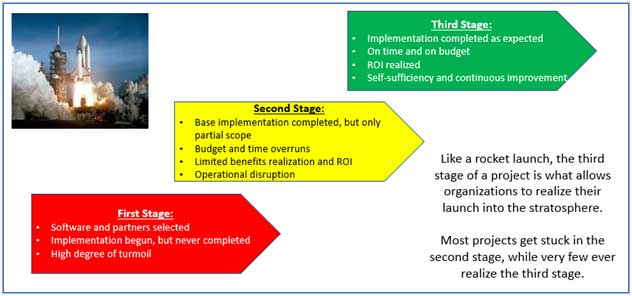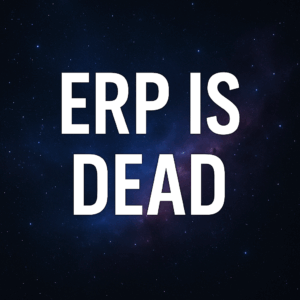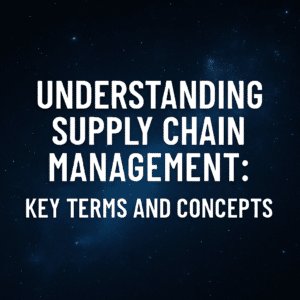If you have been following Third Stage for any length of time, you have probably heard reference to reaching the “Third Stage” of your digital transformation or seen the below graphic:

This is a graphical references of the three stages of a rocket launch in comparison to a digital transformation, suggesting that the third booster of the rocket, or the “Third Stage” is what ultimately defines a successful rocket launch or a successful digital transformation. Most of our writing and thought leadership centers around reaching this proverbial “Third Stage”.
So, why is this concept so important and what does this mean to you and your current initiative? What we find is that most companies and leaders understand the general concept of this analogy, yet when it comes down to time and budget discussions most still don’t draw the connection to their own project.
To help, let’s first take a deeper look at the definition of these three stages of digital transformation:
Table of Contents
ToggleFirst Stage of Digital Transformation
The first booster of a rocket is critical in getting the vessel off the ground. Similarly, the first steps of your transformation, such as purchasing a software package, defining your team and outlining your future direction, is a critical first step if you are going to go anywhere.
It takes a tremendous amount of power and fuel (i.e. money and organizational momentum) to get off the ground and begin propulsion towards your future goals. However, if the second booster is not ignited shortly thereafter, the Earth’s gravitational pull will take over before the outer layers of the atmosphere are even reached. We have seen some very unfortunate examples of this in the past.
The percentage of digital initiatives that fail in the first stage are fortunately very low, less than 10% by our estimations. These would be the horror stories and ERP software implementation failures that you read about such as Hershey’s, Lidl, Waste Management, Nike, and others.
Second Stage of Digital Transformation
The second stage of a rocket launch is what pushes the vessel through the various layers of the Earth’s atmosphere and into the Thermosphere where it can then prepare for orbit. The second stage of your digital transformation can also be defined as “implementation”.
It is important to note, however, that once through implementation, you are not done with your transformation. There is a dangerous misconception that once a software is “live” that the implementation has been successful. Consider a rocket that launches successful and enters outer space, only to realize that it doesn’t have a clear path and has not fully aligned with an orbital trajectory. Essentially, it could continue through the Thermosphere into the abyss of space. It will keep going but eventually run out of food, water, and communication.
Fortunately, rocket engineering is developed enough to keep this from happening too often, but we don’t see the same level of success with digital transformation. We estimate that nearly 60-80% of transformations gut “stuck” in the second stage. This means that the software is implemented, but it is not optimized. People are still using workarounds, operational disruption is the norm, and return on investment (ROI) is a long-lost concept. Similar to the rocket leaving the reaches of the atmosphere, settling in the second stage of a digital transformation will eventually leave your technology infrastructure without a clear direction or purpose.

Third Stage of Digital Transformation
In both rocket and digital transformation analogies, we can use the term “payload”. Think of the most basic form of a rocket, the firework. The payload is the “explosion” that makes people smile and clap. In your digital transformation, the payload is the resulting benefit that was the initial intent of your implementation in the first place. If you never reach the payload, we have to question if the entire initiative was worth the effort.
The Third Stage of digital transformation is not a standalone event, either. Without the first two stages getting you started and headed in the right direction you will never get to your goal. For this reason, the concepts of orbit, self-sufficiency, and ROI should never be lost during your transformation initiative. Along with maintaining the vision of where you are headed during implementation, achieving the Third Stage takes effort following “go-live”. Topics such as organizational design, business process management, continuous training, and benefits actualization should remain in scope, eternally.
In summary, consider that reaching the Third Stage of your digital transformation, whether it is implementing one of the top ERP systems, leading HCM systems, or top supply chain management systems, it should be viewed as an absolute necessity rather than a simple “nice to have” goal. We are no longer in a time where simply implementing a new system is enough to provide any level of competitive advantage in the marketplace.
As you read case studies, best-practices, and other publishing surrounding digital transformation, keep the analogy of the “Third Stage” in mind. And please feel free to contact us if you would like to brainstorm ideas regarding your digital transformation. We are happy to be a sounding board as you continue your journey!





